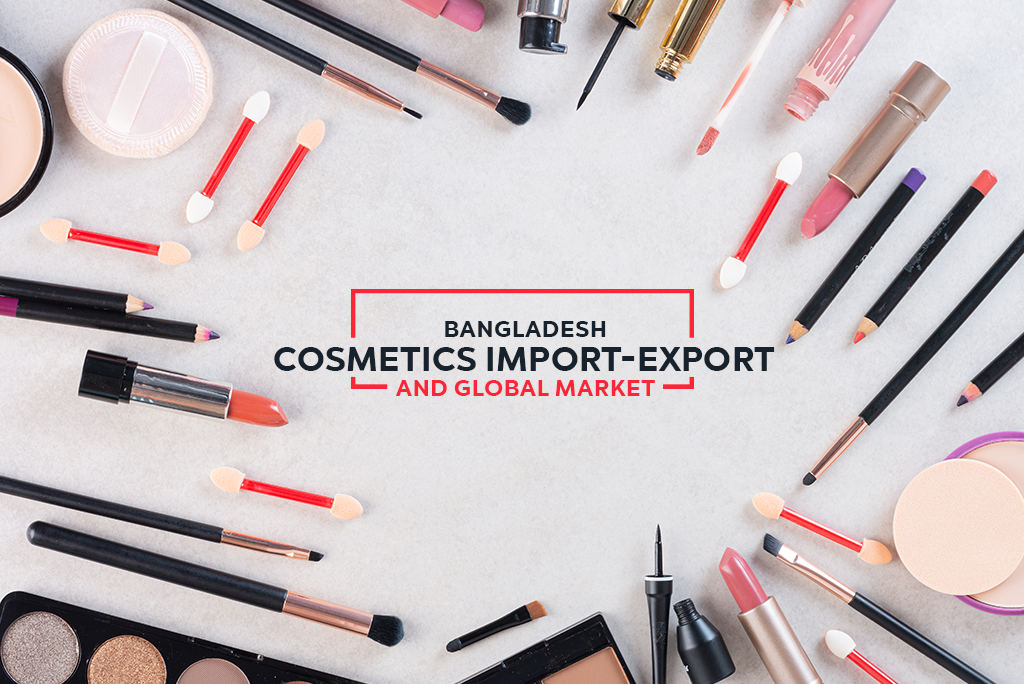Filled not only with an abundance of products but also opportunities, the growth of the cosmetic industry is exponential, and it is increasing gradually too. The cosmetic industry of Bangladesh is in a rising state, and it is not only growing in the usage of beauty products but also increasing in the local manufacturing. Bangladesh’s cosmetic industry is bolstering with the passing of years and the inclusion of everyone using the products for their own purposes and objectives.
Bangladesh’s skincare industry (a part of the cosmetics industry) was valued at $1.23 billion in 2020, primarily due to the rising trend in the use of makeup products on social media platforms. The skincare industry of Bangladesh is expected to rise by a CAGR of 8.1% within the next few years, reaching a value of $2.12 billion by the end of 2027. Take a look at the international trade statistics in support of the study conducted by Market Inside to understand the market of beauty products, both in Bangladesh and globally.
Bangladesh Cosmetic Industry and Trade
Bangladesh’s beauty industry (casual for the cosmetics industry) dates way back to the 90s when several international brands entered the market of Asian regions. The immediate big capture might be in countries such as Korea, India, China, and Singapore, but a sluggish influence on Bangladesh. There is a limited resource of information on how cosmetics ‘entered’ the market of Bangladesh, but perhaps we know how it ‘grew’.
According to a study conducted by Japan Bangla Business Center, Unilever Bangladesh plays an important role in boosting the beauty industry in Bangladesh. In 2006, the fast-moving consumer goods accounted for a 6.7% growth in its increase in Bangladesh. This implies a heavy reliance on the imports of cosmetics with little to low domestic demand and imports of all the ingredients/raw materials to manufacture a few cosmetic products by international brands.
The representation of the Bangladeshi imports for cosmetic products in pre-pandemic and during a pandemic are shown below through the years 2019 and 2020. The classification of HS Code for the imported products is Heading 3304 which includes all the beauty products including the products meant for the purpose of skincare.

Bangladesh imports the ingredients for beauty products manufacturing from countries such as India, Singapore, Thailand, and China. The below represented Bangladesh import data features the top imports of main ingredients of beauty/cosmetic products in Bangladesh for the past 2 years, excluding 2021 (2019 and 2020). The total value of each year is shown in a total sum for each product.
The main ingredients taken into account for the manufacturing of products are featured and retrieved from Bangladesh imports 2021-2022 as per the availability. The classification of HS Code for each shown product is as follows:
- Paraben – Subheading 291631
- Gluconic Acid – Subheading 291816
- Lactic Acid – Subheading 291811
- Essential/Aromatic Oils – Subheading 330129
Paraben’s subheading is based on its origin being the esters of 4-hydroxybenzoic acid, a derivative of benzoic acid. The total import value for “Salicylic Acid” is presented, combined with the value of “Salicylic Acid Esters” by using the ‘product description’ filter in our intelligence platform online.
The Existing Factors and Upcoming Trends
There has been a shift among consumers in Bangladesh who gravitate toward organic skincare products and lesser toward the international products imported from other countries such as South Korea, China, the USA, or India. This also encouraged the domestic manufacturers to take the opportunity in their hands to increase the production units in their own country.
Alongside the local manufacturers, the dealers also distributed the beauty products to Bangladesh’s market through imports from other countries of international brands. The demography of Bangladeshi consumers also brought an upward trend in demand, as per a report. Males have also begun to use cosmetic products to maintain and lead a healthy lifestyle. On the contrary side, this also means that imported products are higher than exports.
The major concern that comes here is whether the cosmetic industry in Bangladesh is flourishing or not in terms of its exports to other countries. As evidenced by the representation of the import data of Bangladesh above, the major ingredients to manufacture cosmetic products domestically are imported worth million of value. This implies that local manufacturers present in Bangladesh are fulfilling the domestic demand with local manufacturing, but are they producing enough to export or are they even exporting.
Bangladesh export data below represents the values of total exports for the beauty products exported in the country from 2019 to 2021. The value of exports for beauty products declined each year from the year 2019 to the end of 2021. While 2019 amounted to $147.8 thousand worth of exports, 2021 amounted to $27.1 million. The imports of beauty products are in a million while exports are in the range of USD thousand, implying exports are way lower than imports.

Although Bangladesh’s cosmetic industry domestically is not benefitting as there is a high reliance on the imports of raw materials to manufacture the beauty products, there has been a growth in the consumer demand propelled by the change in consumer behaviour towards these products, especially after the COVID-19 pandemic in 2020 that brought influences from social media. Opportunities for both international suppliers and domestic manufacturers exist.
Rising Market of the Cosmetic Industry—Globally
The cosmetic industry is a wide market with mainly 4 types of products attached with their own specific usage. This industry consists of different beauty products intended for different purposes and is segmented into products meant for uses such as—Decorative, Skincare, Hair Care, and Aromatic.
The representation of the top countries importing and exporting beauty products under the HS Code Classification of Subheading 3304 is shown below for the year 2021. As evident in the shown import-export data 2021, the majority of the countries have high values for both imports and exports. This implies that many countries have high manufacturing units that made it possible for exports, but the consumer demand domestically influences the imports.

The highest robust market for this industry is in the European nations, among which Italy is the most volatile market for these products in the whole European market. According to Switzerland Global Enterprise, as per studies conducted for the year 2020, Italy ranks third place in Europe for its third party manufacturing sector amounting to 4 billion euros in 2019.
The cosmetic industry has an annual growth rate of 4.75% which is driven by the consumer demand in the e-commerce market. The increasing quality of life, growth in income, social media influences, ethical practices, and major other factors have contributed to the increasing demand for cosmetic products, among countries in all the demographic—consisting of every gender, race, and ethnicity. This is expected to increase more in the upcoming years as people choose to be presentable and develop healthy habits to take care of themselves in every way.




GIPHY App Key not set. Please check settings